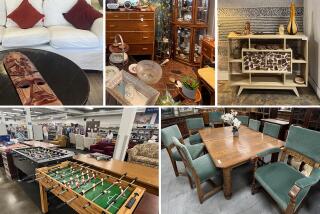Turning the Tables on the Internet
- Share via
Here are some pros and cons of furniture shopping online.
The pros:
* It saves time. You can visit lots of sites quickly.
* With promotions to lure first-time customers and free delivery, prices are good.
* Thirty-day money-back guarantees with free return shipping lower the risk factor.
* No salespeople on commission loom over you.
* You can shop when it’s convenient.
The cons:
* You can’t touch or see the actual piece.
* Some name brands don’t want to alienate their retailers so they don’t sell online.
* You don’t have a salesperson or store designer at your elbow to help you.
Furniture buying often involves virtual reality and a leap of faith. You pick out a finish and a fabric, put down a hefty deposit, and hope the chair that arrives on your doorstep three months later is something like the chair of your dreams.
Given that, is it such a stretch to buy a chair online?
Yes, says Henry Shofer, president of Shofer’s Furniture in Federal Hill, Md.
“You can give yourself a pretty good education and see what’s out there without leaving home,” he says. “But it’s difficult to tell what the finishes and fabrics are like on the Web.”
No, say the “e-tailers” who have created an explosion of new Internet sites selling home furnishings. (Forbes magazine has called furniture one of the hottest retail categories online.)
Some e-companies send out swatches before you place an order so you can see and feel the fabric. You can get free advice from their design consultants by e-mail or telephone. Shipping is often free. And a 30-day money-back guarantee (with return shipping free as well) is becoming more and more standard.
“My guess is that they’re taking some huge hits to establish themselves,” says Brian Carroll, online editor for the High Point, N.C.-based trade newspaper Furniture / Today. “The hard, cold fact is that under 5% of those shopping for furniture end up buying it online.”
Carroll has done a little e-furniture shopping himself; he purchased a mirror for $150 from Goodhome.com.
“I was comfortable at that price level,” he says. But he wouldn’t buy a sofa or wood furniture from an e-tailer. “I want to look at that finish. I want to see the hundreds of years of tree in the wood.”
Saving time is the big draw of e-furniture shopping. Yes, there are price breaks because these stores don’t have to stock inventory. And being able to shop in your bathrobe is convenient. But most important, on the Internet you can visit dozens of home-furnishings stores in a single evening.
Finding the right furniture takes time--something most people these days just don’t have enough of. It’s no wonder that consumers, having tasted the joys of buying books at Amazon.com, are ready to move on to Living.com or Affordablefurniture.com when they want to get, say, a mission-style sleigh bed for under $2,000. A bricks-and-mortar store may carry 30 or 40 manufacturers; an e-tailer like Furniture.com represents as many as 200 makers of bedroom furniture.
“It puts the power in the consumer’s hands,” says Mark James, who handles public relations for Living.com. “There’s no salesman, and no pressure.”
Living.com, which was launched last September, offers more than 10,000 products for the home, from coasters to couches. Its management team has experience in both merchandising (like the vice president who was previously with Bloomingdale’s) and technology (a vice president formerly with America Online). The combination is typical for furniture e-tailers.
Living.com gets an average of 70,000 virtual visitors a day. It and other sites, though, won’t say how many orders are placed, so it’s impossible to tell whether people are actually buying or are simply using the Web to learn about furnishings before they go to a traditional retailer to make their purchase.
Still, there’s no denying that home-furnishings sites are great sources of information.
“Is the Web better than a fabulously informed salesperson at your elbow?” Marilyn Bellock, co-founder of Goodhome.com, asks rhetorically. “Probably not, but he’s not easy to find.”
In his place, sites like Goodhome.com offer a wealth of product information, online decorating magazines, design consultants and interactive room settings.
“We’re investing in the consumer’s learning curve,” says Bellock.
You can set up your own file on the sites and store images, then come back to them when you’re ready to buy. Or e-mail them to friends to see whether they prefer the armoire in oak or walnut.
As time passes, the dot-coms are getting more sophisticated in competing against real-space stores.
“The sites continually change,” says Rose Mauriello of Furniture.com. “You can do that online very easily: sales, coupons, promotions, miles or points on credit cards. They can reinvent themselves quickly.”
Still, most people want to buy furniture they’ve looked at, felt or sat on. That’s why industry analyst Brian Carroll thinks the most successful e-tailers will be what he calls “clicks-and-mortars”--those that combine a Web site with a bricks-and-mortar store.
“Ones that can blend the best of both worlds [like the Web site Ethan Allen is developing],” he says, “will do best.”
(BEGIN TEXT OF INFOBOX / INFOGRAPHIC)
Online Sources
Yes, you can visit a dozen furniture stores in an evening. Here are some suggestions:
* https://www.furniture.com
* https://www.living.com
* https://www.goodhome.com
* https://www.affordablefurniture.com
* https://www.furniturefind.com
* https://www.homepoint.com
* https://www.behome.com
* https://www.furnitureonline.com
* https://www.rtaonline.com
* https://www.home123furniture.com
* https://www.postvictorian.com
* https://www.furnitureplaza.com


